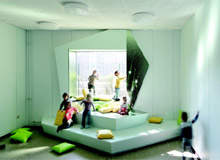
If you thought it was hard to make school appeal to the average child, imagine designing for those who hate school and have been expelled from as many as five.
A handful of leading European architects have created inviting spaces for marginalised children (many from immigrant families) facing a multitude of urban problems, including poverty, downtrodden neighbourhoods and unstable families. In every case, the architects aimed to create a magnet for the children – a place that would draw them in and create a sense of belonging.
When designing kindergartens in Berlin for children from turbulent families, architect Susanne Hofmann of Baupiloten wanted the children to identify with the space, so she created fanciful installations.
At Taka-Tuka-Land, a kindergarten inspired by a Pippi Longstocking book, Hofmann loosely construed the building as an old oak tree. And at the Tree of Dreams Kindergarten, another 'tree' fills much of the interior. This almost animate creation snores, giggles, moves and shimmers, inviting children to interact with it and lounge in its giant blossoms.
In a rough part of Copenhagen, an older crowd presented architect Julien de Smedt of JDS with a very different challenge. He designed the Sjakket Youth Centre for troubled teens that have been expelled from school. The centre appeals to them precisely because it offers freedom. Also, it's not a school but a place to socialise, exercise and learn cultural arts. A former skateboarder, de Smedt has provided the teenagers with architecture so sturdy that that they can skateboard inside.
See Also:
In Roermond, in the Netherlands, architect Erik Schotte of LIAG also created a space for teenagers. This group is on a vocational track and will likely leave school at 16. With bright colours inside and out, the Niekée Centre welcomes students who might feel enormous resistance to entering an academic building. Once inside, they find themselves underneath brilliantly hued rooms that seemingly float in the spacious atrium.
How well do you really know your competitors?
Access the most comprehensive Company Profiles on the market, powered by GlobalData. Save hours of research. Gain competitive edge.

Thank you!
Your download email will arrive shortly
Not ready to buy yet? Download a free sample
We are confident about the unique quality of our Company Profiles. However, we want you to make the most beneficial decision for your business, so we offer a free sample that you can download by submitting the below form
By GlobalDataCOLOUR MYTHS AND TRUTHS
The students have given Schotte overwhelmingly positive feedback about the environment. But in working with such a bold palette, he may have taken a risk. Designers often believe that young people gravitate toward saturated primary colours or toward soothing 'ice cream' colours, such as pistachio and lemon. But some environmental psychologists maintain that research doesn't support any of these assumptions.
Roger Hart, an environmental psychologist at the City University of New York, rails at myths that children have universal aesthetic preferences.
He says, "There's a tremendous tendency to think that children are less than complete individuals and that their perceptual development is delayed for years, but it really isn't. Except for babies up to about three months, children have tastes just like adults do."
Susan Goltsman, an environmental psychologist at MIG in Berkeley, California, agrees. She has seen two-year-olds with pronounced tastes. By age three, she says, "they can get pretty sophisticated about their likes and dislikes of everything. They get opinionated very quickly."
Colour, she asserts, should match the function of a place. In a dance studio, youth centre or a place where kids make music, vibrant colours work well. In other situations, a beige palette and indirect lighting can turn a space into a soft, comforting, supportive environment that fades into the background, enabling people to take centre-stage.
THE IMPORTANCE OF VARIETY
Ideally, say Goltsman and Hart, an environment for children will offer a wide variety of choices, affording a range of activities, even if that means riding tricycles inside, napping or using finger-paints.
To that end, says Hart, an early childhood environment needs multiple surfaces: a cosy, soft, quiet area to retreat to; a hard but warm surface on which to build and draw (children don't always choose to write on tabletops); a surface such as cork or wood on which to run and even fall; and a washable, drainable, non-slip surface on which kids can make a mess.
Hart says, "I can't tell you how many childcare centres don't have that. They have all kinds of expensive furnishings. But they don't have the thing they most need, which is the messy area."
Lacking that, teachers worry so much about cleanup that they limit the materials they put out for children. With more surfaces, kids find that their opportunities and choices increase considerably.
SCALE
Variety also applies to the matter of scale. Children younger than 12 need child-sized amenities, including small toilets and low drinking fountains. In a building for children of all ages, designers might opt to use several scales for these items. Child-sized amenities can make kids feel that someone has provided spaces just for them. Children crave small places to hide out, adult-free sanctuaries to call their own.
But in reality, children's environments aren't devoid of adults. As Goltsman notes, "Children don't come by themselves. The environment has to work not only for the child, it has to work for every level of person that's interacting with that child, including teachers, caretakers and parents."
INTERACTING WITH THE ENVIRONMENT
De Smedt believes that, compared with adults, kids have a tendency to use architecture a little more. Recalling his skateboarding days, he says, "Skateboarding is very brutal to architecture, but it celebrates architecture in a way, because you use it all the time. You slide, you grind, you use handrails, concrete or wooden benches and sidewalks."
Because skating raised his awareness of materials and of urban environments, he says, "I think of the urban environment as a place to be used. I'm trying to do things that can activate people's use of architecture."
He doesn't worry that the troubled teenagers might vandalise the Sjakket Youth Centre, and he doesn't distinguish between designing for that population and any other: "I don't see any difference. For me, they're kids. It's hard enough to decide what's right and wrong to do for people in general.
I would rather think of what would excite people and what would make them interested in using architecture. I don't want to be overly controlling."
ARCHITECTURE WITH SENSORY APPEAL
Like teenagers, young children interact with their environments and learn from those interactions. In the Tree of Dreams Kindergarten, as light bounces off the tree's glittery leaves, children observe the phenomenon of reflection. If they shake the branches of the tree, it giggles. And when groups of two or three children lean back in the biggest blossom, the tree snores deeply. Then the leaves descend slightly, and the tree makes ocean-like sounds.
Hofmann intentionally created 'tangible architecture' that appeals to the senses.
Knowing that children quite like having different experiences, she created a dynamic environment in which lights, colours and sounds shift. Sunlight penetrates deeply into the building, making the blossoms glow. After sunset, artificial lights gleam, changing the ambiance once more.
NON-LITERAL, FLEXIBLE PLACES AND FORMS
Conventional wisdom often dictates that architecture for children should calm them down, but Schotte, de Smedt and Hofmann all aimed to stimulate. Hofmann tried to do this by leaving her concepts unfinished.
When one enters the Tree of Dreams Kindergarten, she says, "You don't see a Tree of Dreams. You see walls and glowing seats." Hofmann notes that both of her kindergartens have themes, but they're so abstract that the children can dream further. It's important, she feels, to trigger children's imaginations, "I think if you get too literal, the children lose interest."
In the same vein, she believes furniture should have abstract shapes. Children might interpret such an object as something to lie on or as a chair. They can then experiment with various uses for those forms and different ways of sitting and lying.
BREAKING THROUGH THE LIMITATIONS OF THE ADULT MIND
Studying with Archigram from 1988 through 1992 helped break open Hofmann's mind, pushing her past the clichés and conventions of design. She says she now designs playfully by believing in her intuition and thinking about children's inner worlds.
This has sometimes proved problematic. When explaining her whimsical Taka-Tuka-Land design to prospective builders, Hofmann reasoned, "Pippi Longstocking would only have wood. I couldn't imagine that she would work with steel. And she would just start building, not thinking of a system."
Hofmann had to part ways with one engineer who 'didn't have that much fantasy'. Otherwise, she mostly succeeds in getting all the workers into the invented world.
Hoffman occasionally wonders if people think her mad. Laughing, she explains, "I'm so much in this world that it sometimes doesn't occur to me that some people aren't yet with me."





